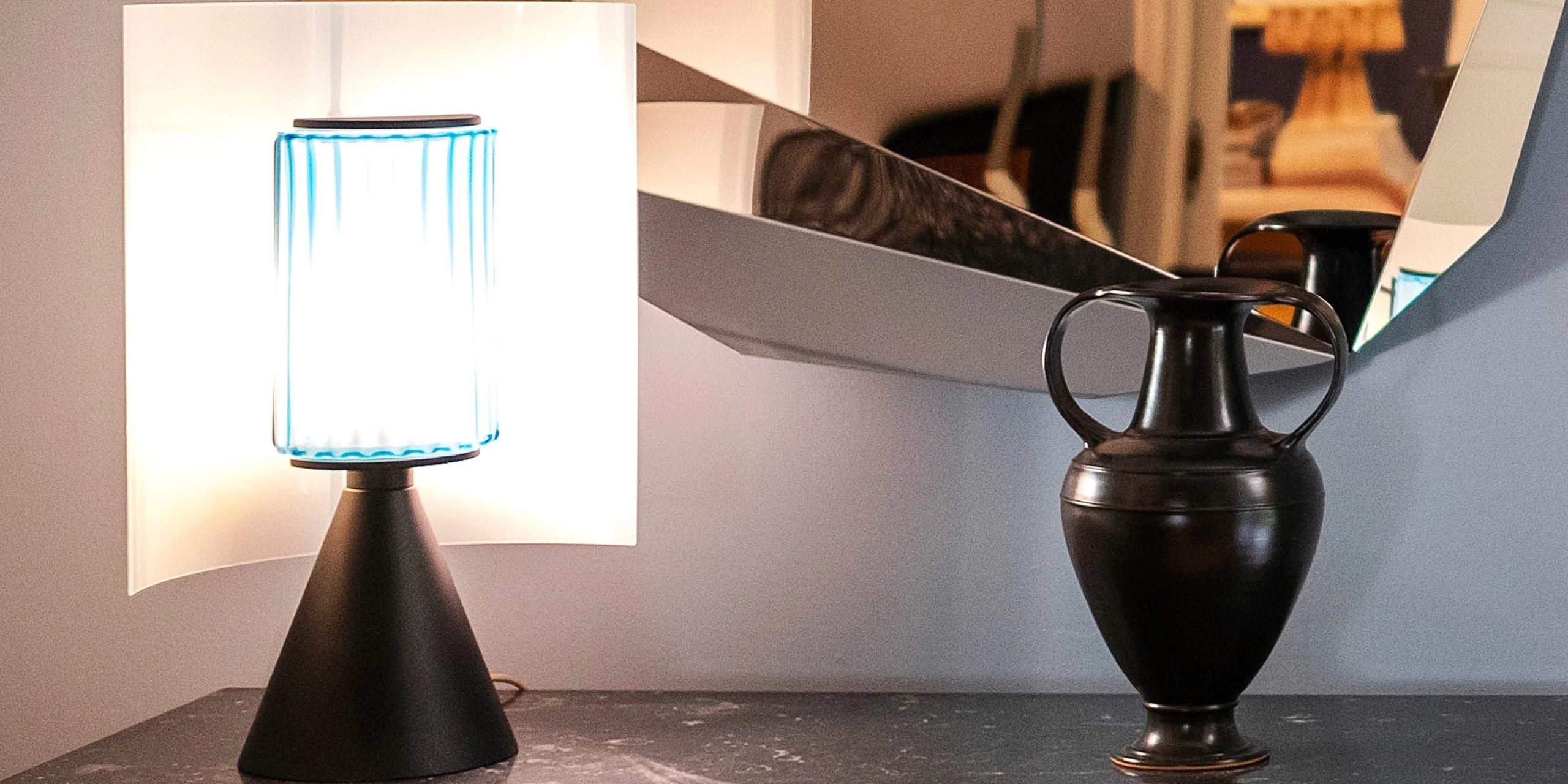
Ancient Greece is famous for its effect on thought, art, and democracy.
Key Highlights
- Greek pottery shows the art, skills, and culture of ancient Greece. It gives us a look into their daily lives, stories, and beliefs.
- The history of Greek pottery started in the 8th century BCE. It grew from basic shapes to stylish forms and methods.
- From the strong designs of the Geometric period to the innovative black- and red-figure styles, Greek pottery shows a change in artistic expression.
- Ancient Greek potters learned to use clay, the potter’s wheel, and firing methods. They made containers that were useful and also very beautiful.
- Greek pottery was important for more than just everyday use. It had a vital part in rituals, trade, and art. It showed the values and beliefs of people in ancient Greece.
It also shaped the world with its lovely pottery. According to the World History, old Greek pottery gives us useful insight into the lives, beliefs, and art of this ancient culture. The history of Greek pottery shows how these pieces range from simple items to detailed artworks, and they still impress us today. They attract us with their beauty, skill, and the stories they tell.
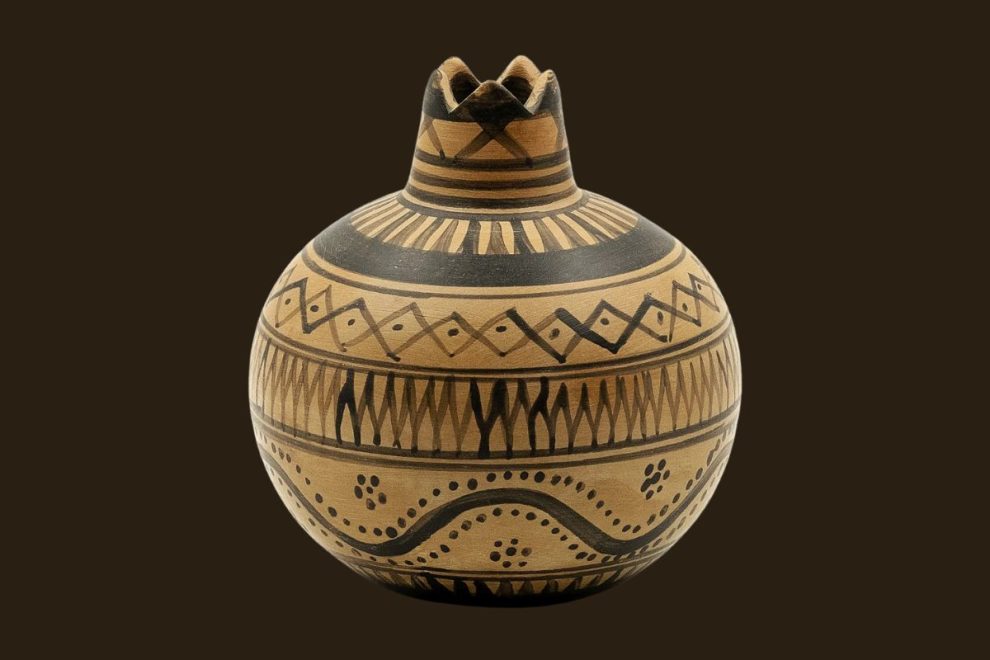
Origins and Evolution of Greek Pottery
The history of Greek pottery goes back a long time, even before history was recorded. Early pottery showed up in the Stone Age. As different civilizations appeared and disappeared, the styles of pottery changed as well. These changes revealed the culture and art of each period. During the Bronze Age, pottery became more detailed. The Minoans and Mycenaeans made distinctive styles that showed the art that would grow after. The true start of what we see today as ancient Greek pottery began after the Greek Dark Ages.
The Birth of Greek Pottery
In the 8th Century BCE, a new kind of pottery began in Greece. This style is known as Protogeometric. It was different from the older Mycenaean styles. Protogeometric pottery was simple and featured geometric designs. This new way helped Greek pottery to develop and flourish. Athenian potters used a one-of-a-kind orange clay called Attic clay for their work. They added circles, lines, and other shapes. These designs brought order and balance. This showed the culture’s revival during that time.
The early pottery was often large and impressive. These pieces were not only for daily use. They also played an important part in burial customs. They marked graves and were put with the dead for their journey into the afterlife. This was the beginning of Greek pottery changing from simple items to ones with significant cultural and spiritual meaning.
Key Periods in History of Greek Pottery
By the end of the 7th century BCE, Greek pottery entered a new time called the Geometric period. Artists put in a lot of effort to make better geometric designs. They included detailed patterns like meanders and triangles. These designs often covered the whole surface of the pots. They showed the skill of the potters. When the Archaic period started in the 6th century BCE, many things changed. Artists began to include human and animal figures in their works. This change was important because it led to the story-telling art that defined Greek pottery.
During this time, Greek art started to be influenced by cultures from the East, like Egypt and Assyria. You can see these influences in new designs, such as the sphinx and griffin. There was also more detail and decoration in Greek pottery. This blend of styles began a golden age for Greek pottery.
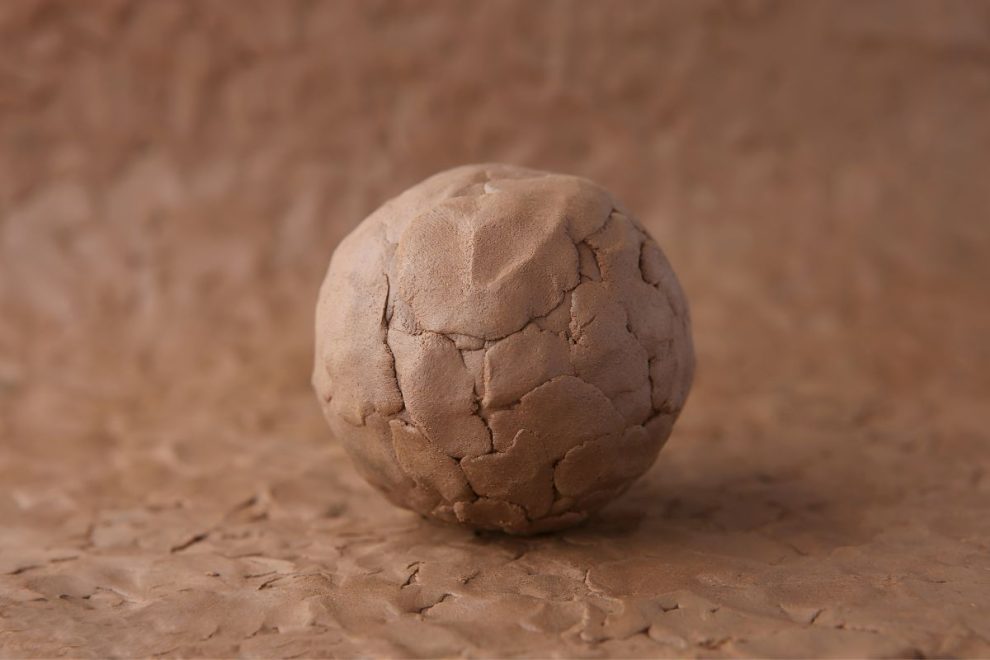
Materials and Techniques of Ancient Greek Pottery
The lasting beauty and careful design of ancient Greek pottery demonstrate the great skills and smart techniques used by the creators. A strong understanding of their main material, clay, was important for this craft. Their skill with the potter’s wheel was also important. This tool helped them make smooth and beautiful shapes. Together, these elements built the foundation for the art of Greek pottery decoration.
The Clay: Composition and Sources
The remarkable style of Greek pottery, especially Athenian pottery, comes from the qualities of the clay used. For example, the high iron in Attic clay gives Athenian pots their warm, orange-red colors. Athenian potters didn’t only use local clay. They searched for certain types of clay from other places. They understood that different clays offered different benefits. For instance, they imported fine-grained clay from the island of Melos to make their slips smoother.
During the Hellenistic period, southern Italy became an important place for making pottery. This area had plenty of clay, allowing potters to use different types of clay. This helped them to make a variety of colors and textures in their work.
Forming Techniques: Pottery Wheel and Molding
The potter’s wheel was used a long time before ancient Greece, but Greek potters improved it. This tool helped them make pots with better precision and even shapes. They turned regular clay into beautiful and useful items. When making big or more detailed pots, the work often had to be done in different sections. The potter’s wheel helped with this. Potters could make parts like the top, neck, and body on their own before carefully joining them together.
In workshops, skilled masters and learners worked together. Their teamwork and wise use of the potter’s wheel helped them make a lot of pottery. All of it had the same styles, which is a sign of ancient Greek pottery.
Firing Process: Kilns and Temperature Control
Turning simple clay into beautiful art requires careful fire management. Firing kilns are designed to heat clay in a safe manner. Maintaining the right temperature is essential for achieving great results.
In Greek vase painting, the famous black-figure and red-figure styles use a tricky three-step firing method. This process changes the oxygen level in the kiln. It helps create the significant black and red colors. Besides the technical parts, firing can be risky and unclear. If the temperature or airflow in the kiln is wrong, it can mess up hours of careful work. When a kiln fires correctly and makes lovely pottery, it shows the potter’s skill and good choices.
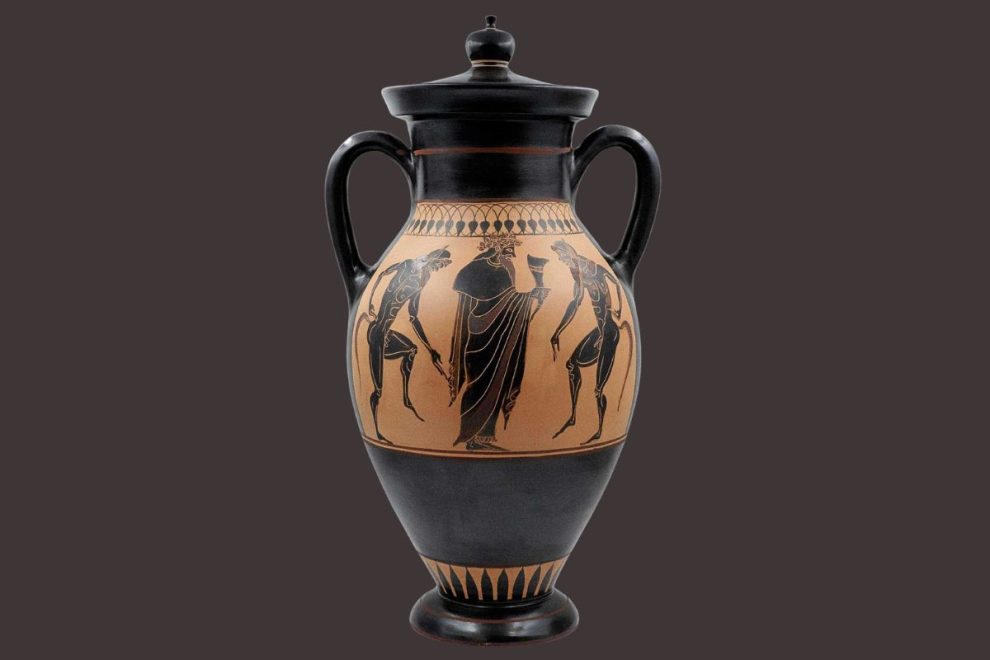
Greek Pottery Types and Their Functions
The world of ancient Greek pottery was not just about pretty vases. It included many shapes and served different purposes. It reflected the daily needs of people and their social and ceremonial practices. Some containers, like amphorae, were mainly for practical use. Others, like kylix, were made for important social events. This shows that pottery was important for more than just usefulness.
Read our related blog articles:
Types of Pottery in Ancient Greece: Transport and Tableware
Types of Pottery in Ancient Greece:Perfume and Ceromial Flasks
Amphorae: Storage and Transport
The amphora is a well-known type of Greek pottery. It has a round body, a long neck, and two handles. This design makes it both useful and pretty. These big pots could be several feet tall. They were important for storage in ancient Greece. People used amphorae to hold wine, olive oil, and grains. These foods were basic for the Greek people. Their strong and spacious design made them good for local use and for trading over long distances. This created a high need for amphorae.
Archaeologists have discovered many bits of amphorae in different places around the Mediterranean. These bits often have markings or stamps on them. They help us understand trade routes and economic activities from long ago.
Kraters: Mixing Wine and Water
The social customs of ancient Greece are shown in the design and use of the krater. A krater is a wide, two-handled pot used for mixing wine and water. The Greeks usually did not drink wine on its own. They believed that mixing it with water made it less strong and better tasting. Greek potters created kraters in different sizes and styles. These vessels played a key role at social events and gatherings. Kraters were often decorated with images from myths or daily life. They served as centerpieces, making these events feel more like celebrations of art and culture, not just regular meals.
The big opening of the krater made it simple to mix, and the handles were helpful for pouring. The mix of potash in Greek clay might have changed the taste of the wine over time because of its acidity. If this was meant or not, it shows how design and use are linked in Greek pottery.
Kylix: Drinking and Celebration
Few objects show Athenian social life like the kylix. This is a shallow drinking cup with a stem and two nice handles that stick out. The kylix often has designs that show parties, sports events, or myths. It gives us a unique view of the enjoyable activities and art styles of ancient Greece. What makes the kylix noteworthy is its lovely shape and how it is decorated. The inside, known as the tondo, usually shows one strong image. This image is often of a person or a story. This choice makes the image stand out when the drinker raises the kylix to drink.
Many kylixes we have today display the mark of one artist. This shows how personal artistic style was beginning to develop in ancient Greek art. These marks usually feature the word “epoiesen,” which means “made it.” They help us learn more about the lives and work of these craftsmen. This changes them from unknown workers into acknowledged artists.
Hydria: Water Carrying and Storage
The hydria is a large pot with three handles that is used to carry and hold water. It shows the mix of function and beauty in ancient Greek pottery. Although it was mainly made for everyday needs, there was still a lot of room for decoration. This illustrates how art played a role in daily life. The hydria usually had one big handle at the back for lifting. It also had two smaller handles on the sides for pouring. This design made it simple to get water from wells or fountains and pour it at home.
The surface of the hydria was like a blank space for artists. They painted stories of myths, images of women doing work, and views from Athenian life. This made everyday items into works of art. Artists used thin black paint with small brushes to make nice shapes and details, showing the rich Greek pottery style.
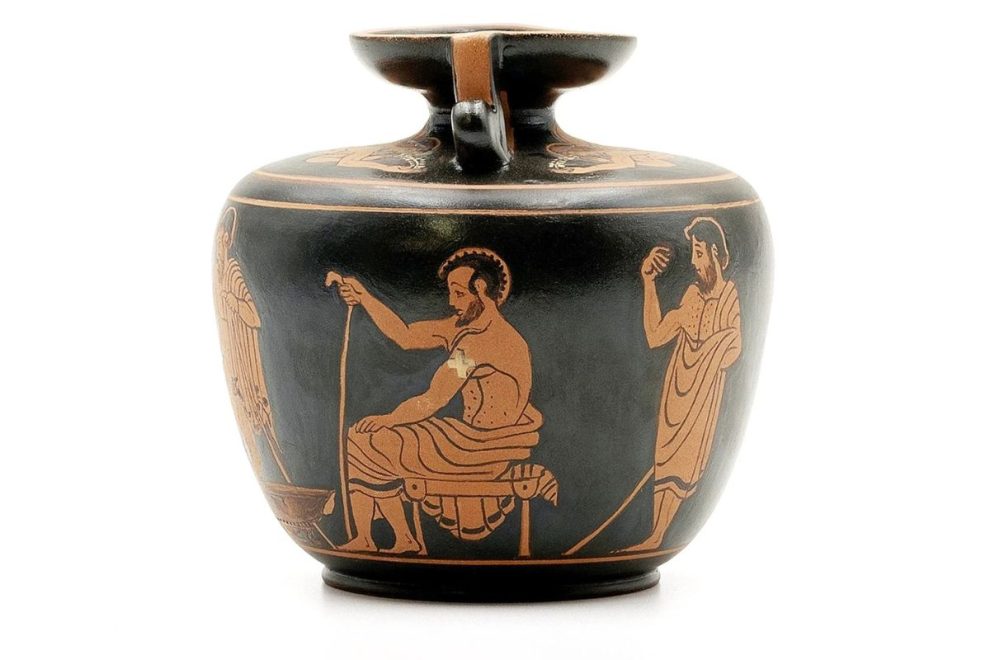
Decorative Styles Through the Ages
The designs on Greek pottery tell us about how art changed over many years. We start with the clear shapes of early pottery. Then, we notice a move to the real-life details of the Classical period. Each design shows the styles and culture of its time. New techniques in pottery played a big role in these artistic changes. The black-figure and red-figure methods allowed artists to show more details in their work. This brought about a key time for vase painting focused on stories.
From Proto-Geometric to Geometric Styles
The Proto-Geometric style showed up after the Mycenaean world came to an end. It brought back a sense of order and simplicity. The strong designs and geometric patterns were intentionally placed on the surfaces of the vases. This reflected a new artistic feel focused on shapes and structure.
These early decorative patterns may seem simple, but they started the Geometric style that was popular in the 9th and 8th centuries BCE. During this time, the designs became more detailed. They included things like meanders, zigzags, and checkerboard patterns. By the end of this time, shapes of people and animals began to show up as decorations. These shapes were created in a simple, geometric style. They pointed to the storytelling part of painting on vases, suggesting the art that would come in new styles.
The Revolution of Black-figure Technique
A key moment in Greek vase painting began with the black-figure method in the 7th century BCE. This method started in Corinth and was soon taken up by Athenian potters. In this method, artists painted figures in a black slip on the natural red clay of the vase. The black slip was made from smooth clay mixed with black iron oxide. It was put on using brushes, creating a place for detailed designs on the pot. Artists would carve into the black slip to show the red clay below. This made fine lines and detailed patterns.
The black-figure style changed Greek vase painting. It allowed artists to show people and animals in a more real way and with more detail. This led to a new time of storytelling in art. Artists often showed scenes from myths, daily life, and sports. They filled these vases with important stories and symbols for the ancient Greeks.
Red-figure Technique and Its Dominance
In the late 6th century BCE, Athenian artists made a new and exciting style called red-figure. This way of painting changed everything by keeping the figures the natural red color of the clay. They also covered the background with black slip. This change gave artists more freedom. They could show details like muscles, clothing, and expressions better. It made the human form look more real and pushed the limits of art in Attic pottery. Red-figure became the main style of Athenian vase painting during the Classical period. The best work in this style usually comes from well-known artists. It turned figure vases into high art, displaying the great skills of Athenian craftsmen.
Later Styles and Hellenistic Influences
After Athens fell in the late 4th century BCE, new pottery centers came up. This was true in the Greek colonies of southern Italy. There, old methods mixed together with local traditions and Hellenistic ideas. This blend resulted in fresh regional styles. One type called West Slope Ware had a simpler and stronger design. These pots often featured bold images and clear shapes. They reflected the changing tastes of the Hellenistic world. In southern Italy, especially in Apulia, a more bold and dramatic style emerged. Large pots with detailed decorations were often created for funerals. They showed several figures, bright colors, and strong drama. This style marked a clear move away from the calm and balanced designs of earlier times.
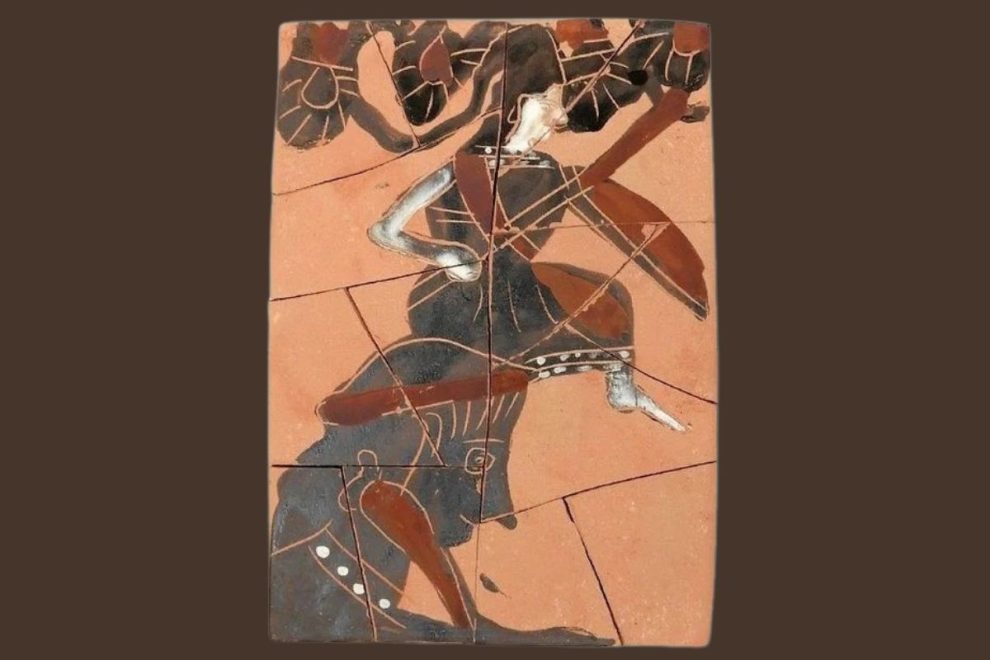
Motifs in Greek Pottery
Greek pottery was not only pretty art. It served as a canvas for many designs, each with its own exceptional meaning. These designs help us understand the ideas, values, and daily life of the ancient Greeks. The pottery displays tales of gods and heroes from Greek myth. It also features scenes from sports and daily life. These designs turned practical items into stories, highlighting the spirit of old Greek culture.
Mythological Narratives and Heroes
Greek mythology is well-known for its fun tales about gods, goddesses, and heroes. These stories came alive with vase paintings. Many vases displayed scenes from popular myths, like the tasks of Heracles or the Trojan War. This made the vases beautiful and a way to share stories. Artists paid attention to human figures in this art. Those who used the red-figure style were good at showing body shapes, clothing, and emotions. This made their characters appear alive and drew the attention of viewers. These heroic stories were not only for entertainment. They also shared important lessons. They taught values like courage, honor, and duty. Young men could learn about good behavior and virtues from these tales.
Daily Life and Athletic Competitions
Not every design on Greek pottery is about myths and legends. Many pots show daily life in ancient Greece. You can see women doing housework, men working in fields or stores, and children playing. These pictures give a clear view of Athenian society. Sports were very important in Greek culture. They were often displayed in vase paintings. Athletes were seen as strong and disciplined. These images showed them in different sports, such as running, wrestling, and chariot racing. These pictures were not only for decoration. They also showed how important being fit and competing were in Greek culture. They captured the idea of having a strong mind and body, highlighting the journey to be the best.
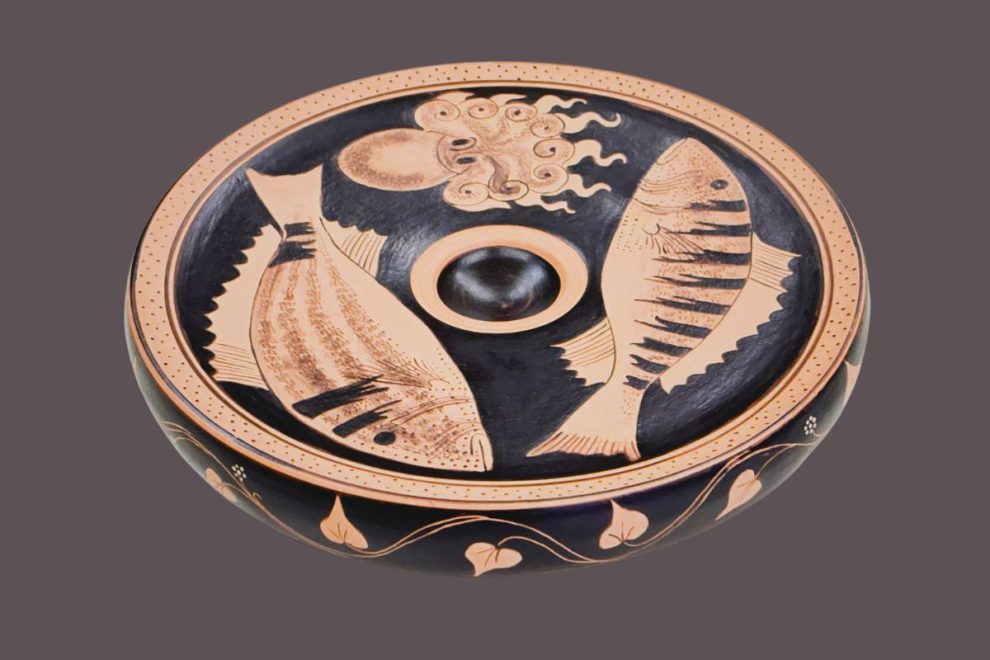
The Role of Greek Pottery in Ancient Greek Society
Ancient Greek pottery was a big part of everyday life. It included not just simple items for the home, but also stunning pieces of art. Greek pottery served more than just as containers. These vessels had important roles in religious ceremonies. They also showed a person’s status and wealth. Moreover, they were important items in trade around the Mediterranean. Studying these vessels gives us great information about the daily lives, social structures, and beliefs of the ancient Greeks.
Religious and Ceremonial Uses
The ancient Greeks showed their religious and spiritual lives through pottery. Greek vases, like large kraters and amphorae, played a big role in religious events. People used them for offerings to the gods and to hold important liquids. Some vases, like the loutrophoros, were used in funeral ceremonies. This tall, narrow vase had a long neck and a wide opening. These vases often showed heartfelt scenes of parting and sadness. They traveled with the deceased on their last journey, showing how important rituals and symbols were in ancient Greek burials.
These vases were used as grave markers to honor those who have passed away. They helped remind people of the lives that these individuals lived and their role in the community. The pictures on these vases held unique meaning related to the afterlife and provided comfort and hope for those still living.
Economic Impact and Trade
The economic effect of ancient Greek pottery reached well beyond Greece. Many people wanted these beauty-made and strong vessels. Greece’s good spot in the Mediterranean helped create a busy trade route. This route went from Spain in the west to the Black Sea in the east. Athenian pottery is known for its high quality and art. It played a big role in trade. Amphorae were very popular for carrying wine, olive oil, and other important goods. These large jars often had the official mark of the city of Athens. Many have been discovered at several archaeological sites across the Mediterranean. This shows the trade routes that linked ancient Greece to the rest of the world.
| Region | Goods Traded | Pottery Types |
| Mainland Greece | Wine, olive oil, pottery, textiles | Amphorae, kraters, kylixes |
| Egypt | Grain, papyrus, luxury goods | Amphorae, alabastra |
| Southern Italy | Wine, olive oil, grain | Amphorae, kraters, fish plates |
| Black Sea Region | Grain, fish, slaves | Amphorae, drinking cups |
Final Reflections
The art from ancient Greece is still visible in their beautiful and well-crafted pottery. When we see the fine details, bright colors, and traditional shapes, we learn more about the skills and culture of this old civilization. Books from Thames & Hudson help us learn more about the history of Greek pottery from ancient Greece. They show us how this pottery can still impress and inspire us today.
